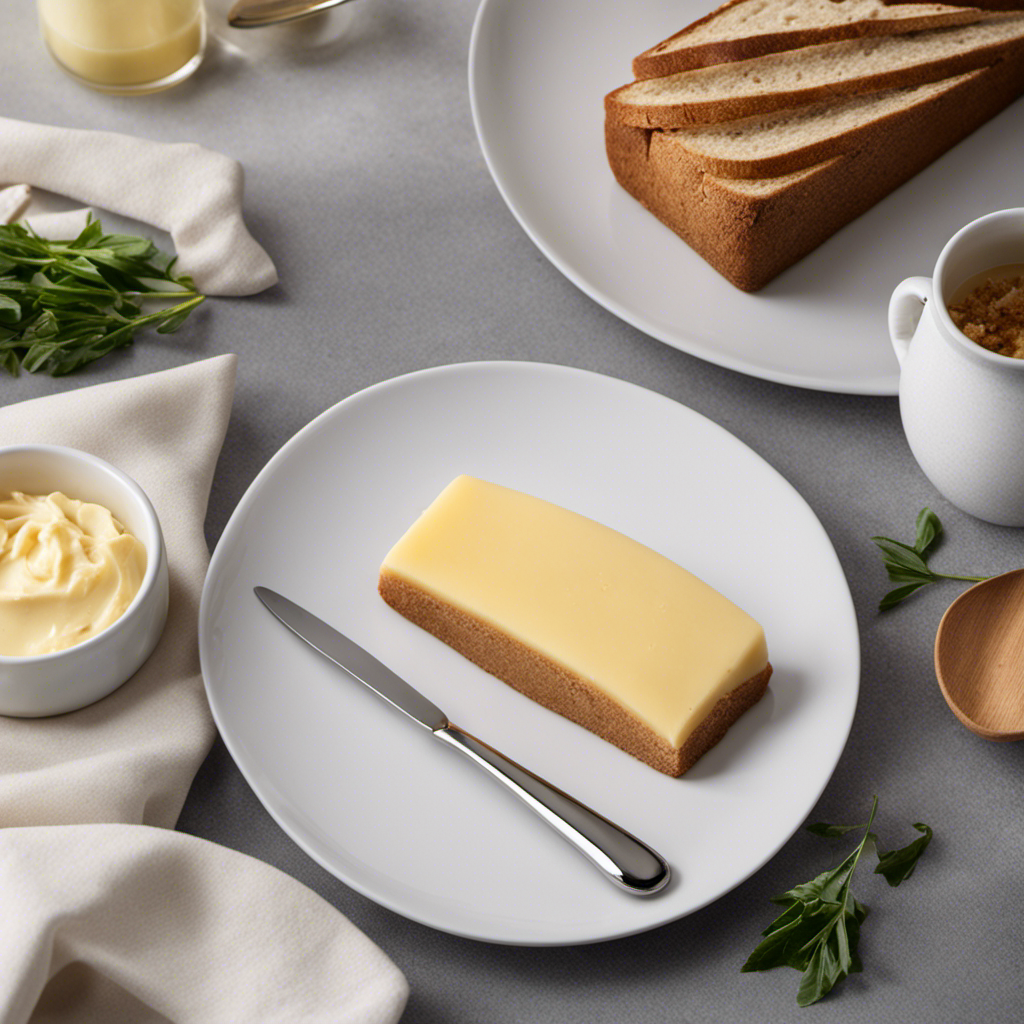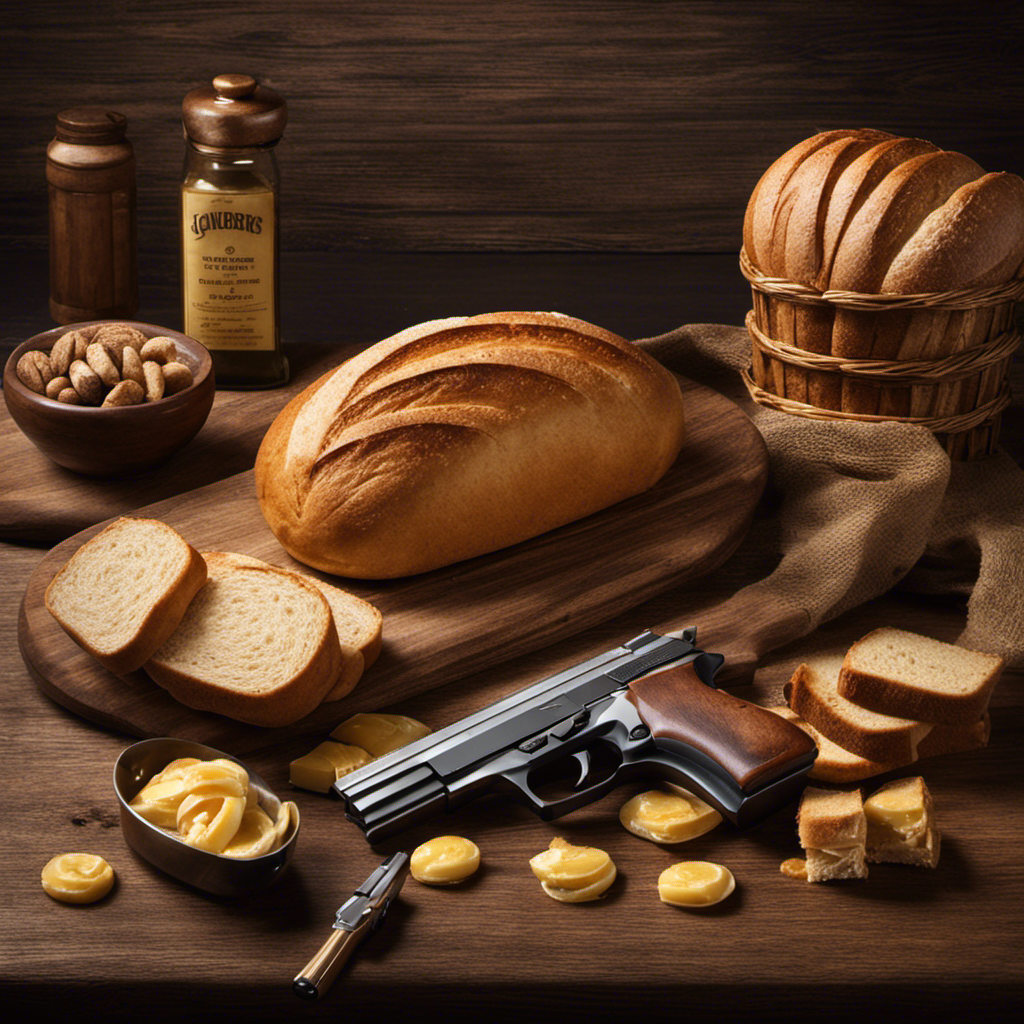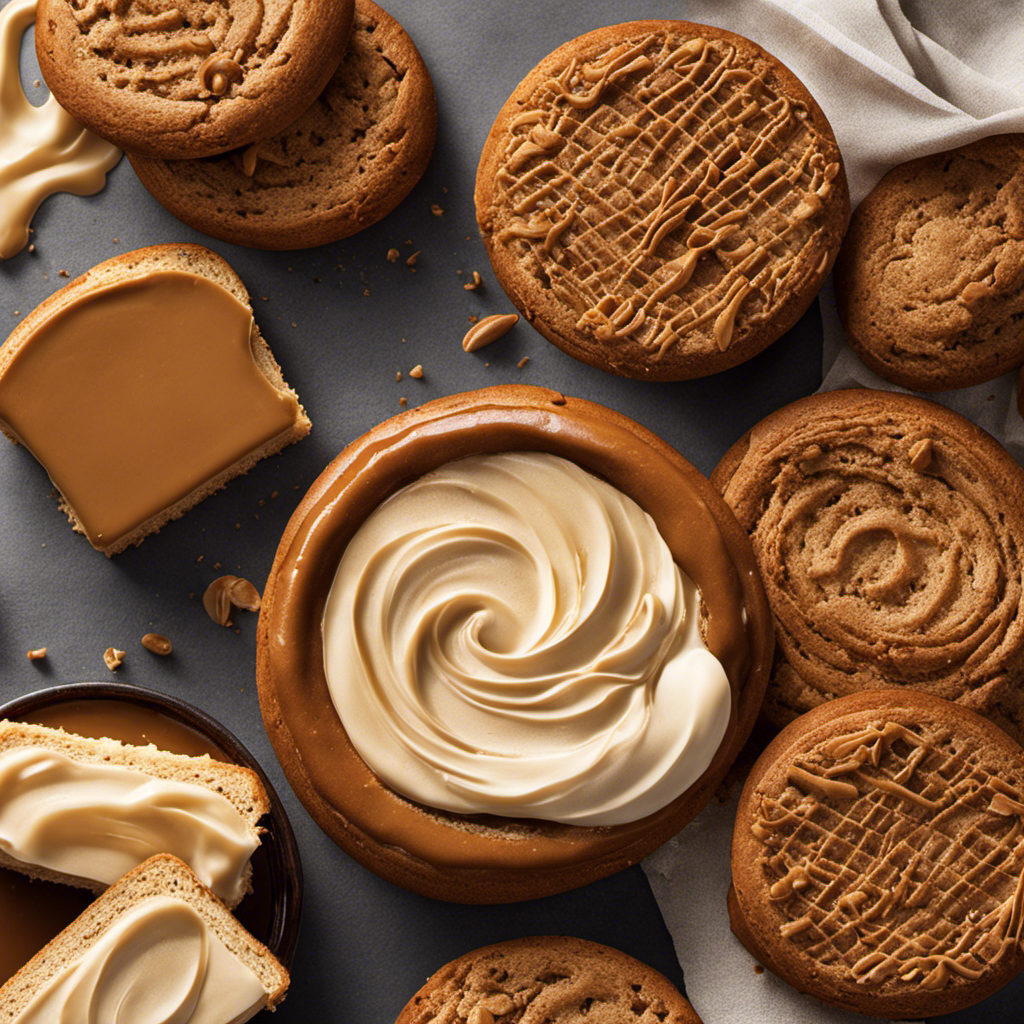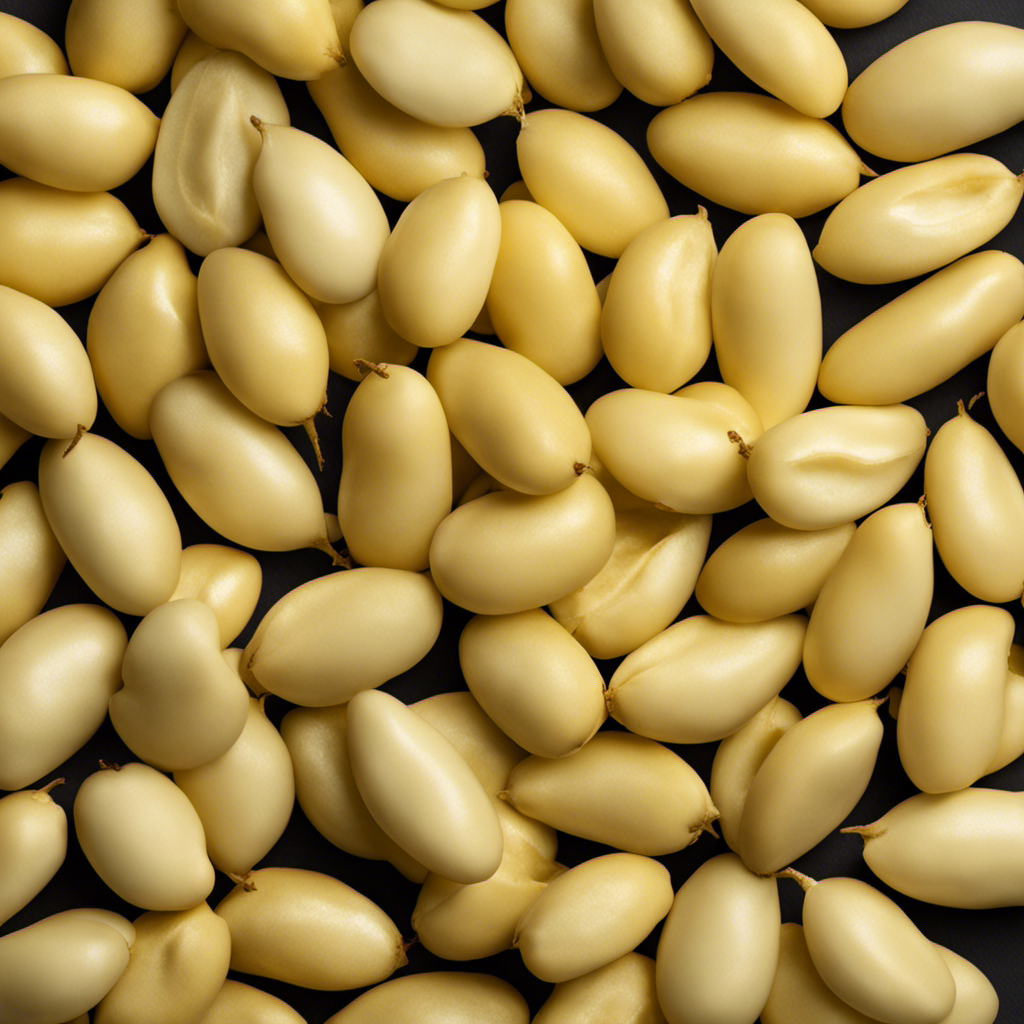Every morning, as I smear smooth butter on my hot toast, I can’t help but appreciate the often overlooked hero of my kitchen – the butter knife. This simple tool, with its slim blade and rounded end, effortlessly cuts through the rich goodness, making it the perfect partner for any breakfast enthusiast.
In this article, I’ll take you on a journey to explore the history, types, materials, and features of butter knives, as well as share tips on how to use and care for them.
So, let’s embark on this buttery adventure together!
Key Takeaways
- Butter knives have evolved over time, from being made from bone or wood to silver and stainless steel, with the addition of a serrated edge for cutting through refrigerated butter.
- There are different types of butter knives with various blade shapes, including curved, straight, and serrated, to accommodate different spreading and cutting preferences.
- Butter knives can have handles made from a variety of materials such as wood, stainless steel, and plastic, offering different textures and aesthetics.
- To maintain butter knives, they should be stored in a dry place, kept away from moisture and humidity, and regularly cleaned and oiled to prevent rust.
History of Butter Knives
If you’re interested in the history of butter knives, you might be surprised to learn that they have been used for centuries. The origins of butter knives can be traced back to ancient civilizations, where they were used as a tool to spread butter onto bread or other food items.
These early butter knives were typically made from natural materials such as bone or wood. As time went on, the evolution of butter knives saw the introduction of new materials like silver and stainless steel, making them more durable and elegant. The design of butter knives also evolved, with the addition of a serrated edge to easily cut through butter straight from the refrigerator.
Today, butter knives come in various shapes and sizes, but their purpose remains the same – to effortlessly spread butter onto our favorite foods.
Types of Butter Knives
When it comes to butter knives, there is more to consider than just their history and appearance.
Two key factors that can greatly affect your butter knife experience are blade shape preferences and handle material options.
The shape of the blade can determine how easily you can spread butter, while the material of the handle can impact the knife’s durability and comfort in your hand.
Let’s dive deeper into these aspects to help you find the perfect butter knife for your needs.
Blade Shape Preferences
You might prefer a butter knife with a curved blade shape for easier spreading. The curved blade allows you to effortlessly glide through butter, making it a popular choice among many.
However, blade shape preferences vary from person to person. Some may prefer a straight blade for precision cutting, while others may opt for a serrated blade for easily spreading thick spreads like peanut butter.
When it comes to handle material variations, there are countless options available. From traditional wooden handles to modern stainless steel ones, the choice is ultimately a matter of personal preference.
Some may prefer the warmth and natural feel of wood, while others may appreciate the durability and sleekness of stainless steel. The handle material can greatly affect the overall look and feel of the butter knife, so choose wisely based on your own preferences and needs.
Handle Material Options
For a classic and timeless look, consider opting for a butter knife with a handle made of polished wood. Wood handles add warmth and elegance to the table setting, making them a popular choice for traditional and rustic-themed occasions. They also provide a comfortable and secure grip, ensuring a smooth and controlled spread of butter or jam.
In comparison, plastic handles may lack the same level of sophistication, but they offer practicality and affordability. On the other hand, metal handles exude a sleek and modern aesthetic, while ceramic handles can add a touch of whimsy and uniqueness.
Ultimately, the choice between wood, plastic, metal, or ceramic handles depends on personal preference and the desired atmosphere for the dining experience.
Materials Used in Butter Knives
Butter knives are typically made from stainless steel or silver. Precision and attention to detail are key in the manufacturing process. Here are some materials used in butter knife production that contribute to their durability and functionality:
- Stainless Steel: This popular material is known for its resistance to corrosion and rust, making it perfect for everyday use.
- Silver: Often used for luxury butter knives, silver adds an elegant touch to the dining experience.
- Handle Materials: From wood to plastic, the handle of a butter knife can vary in material, providing different textures and aesthetics.
Using a butter knife has several benefits. It allows for easy spreading of butter or other spreads on bread or toast. The smooth, rounded edge prevents tearing or squishing of delicate baked goods. Additionally, the flat blade enables even distribution of the spread for a consistent taste in every bite.
Now that we’ve covered the materials used in butter knives, let’s delve into the features and design that make them essential tools in the kitchen.
Features and Design of Butter Knives
When it comes to butter knives, there are a variety of options to consider. Blade shape is one factor to think about, with options ranging from the classic rounded tip to the more modern pointed tip. Each shape offers its own advantages and style.
In addition to blade shape, handle materials also vary. There is a wide range available, including wood, stainless steel, and even plastic. This allows for customization and personal preference when choosing a butter knife.
For those looking to add a touch of elegance to their butter knife, there are many decorative embellishments available. Engraved patterns or ornate handle designs can make the knife not just a functional tool, but a beautiful one as well.
Blade Shape Options
Have you ever considered what options there are for the shape of a butter knife blade? When it comes to butter knives, blade shape options are surprisingly diverse.
Here are three examples to help you visualize the possibilities:
-
Straight Blade: The classic choice, with a straight and flat blade, perfect for spreading butter or jam evenly on your toast.
-
Pointed Blade: This blade shape features a pointed tip, which allows for easy piercing of bread or pastries, making it ideal for cutting and spreading.
-
Serrated Blade: With a saw-like edge, this blade shape effortlessly glides through crusty bread, while still providing a smooth spreading surface for your butter or toppings.
Now that we’ve explored the various blade shape options, let’s move on to another important aspect of butter knives: handle material variations.
Handle Material Variations
Now that we’ve explored the different blade shapes available for butter knives, let’s shift our focus to another important aspect: handle material variations.
The handle of a butter knife not only contributes to its overall aesthetics but also plays a crucial role in its durability.
When it comes to handle materials, there are several options to choose from. Common materials include stainless steel, wood, plastic, and even bone or ivory for more luxurious options. Each material offers its own unique set of benefits.
Stainless steel handles are known for their strength and durability, while wooden handles add a touch of natural beauty. Plastic handles are often lightweight and easy to clean.
Finding the perfect handle material is essential for both functionality and style. As we delve into the world of butter knife design, it’s important to consider the handle material’s durability and aesthetics.
Now that we have covered handle materials, let’s move on to the next exciting aspect: the decorative embellishments available.
Decorative Embellishments Available
Let’s explore the various decorative embellishments available for butter knives, adding a touch of elegance and personal style to these essential kitchen tools. When it comes to decorative handle options, the possibilities are endless. Here are a few ideas to spark your imagination:
-
Intricate carvings: Imagine a butter knife with a beautifully carved handle, featuring delicate patterns and motifs. It adds a touch of sophistication to your table setting.
-
Embossed designs: Picture a butter knife with a raised design on its handle, such as floral patterns or geometric shapes. It creates a tactile and visually appealing experience.
-
Inlay work: Visualize a butter knife with inlaid materials like mother-of-pearl or wood, adding a unique and luxurious touch to the handle.
In addition to decorative handles, unique blade designs can also make a statement. From serrated edges to scalloped blades, these variations offer both functionality and aesthetic appeal. So why settle for a plain butter knife when you can elevate your dining experience with these decorative options?
How to Use a Butter Knife
Using a butter knife, you can easily spread butter or jam onto your toast. However, there are alternatives to a traditional butter knife that can make your spreading experience even better.
One option is a cheese spreader, which has a wider and flatter blade, perfect for spreading butter smoothly. Another alternative is a silicone spatula, which is flexible and can easily glide over your toast.
When using any type of knife for spreading, it’s important to follow some safety tips. Always hold the knife with a firm grip and be mindful of your fingers. Avoid using excessive force that could cause the knife to slip.
Additionally, make sure to clean and dry your knife properly after use to prevent any potential accidents.
Proper Care and Maintenance of Butter Knives
To keep your butter knife in good condition, it’s important to regularly clean and dry it after each use. Here are some tips on how to properly care for and maintain your butter knife:
- Store your butter knife in a dry place, away from moisture and humidity.
- Avoid leaving your butter knife in the sink or dishwasher for extended periods of time.
- To remove rust from your butter knife, soak it in a mixture of vinegar and water for a few hours, then scrub it gently with a sponge or brush.
- After cleaning, make sure to dry your butter knife thoroughly to prevent any moisture from causing rust.
- Regularly oil your butter knife with a food-safe oil to keep it lubricated and prevent rust.
Taking these simple steps will ensure that your butter knife stays in pristine condition and is always ready for spreading butter or other delicious toppings.
Now, let’s move on to some fun facts about butter knives.
Fun Facts About Butter Knives
Did you know that butter knives were originally designed to help spread butter on bread? It’s a fun fact about butter knives that many people may not be aware of. These versatile kitchen tools have been around for centuries and have evolved over time. Today, butter knives come in various shapes, sizes, and materials, but their purpose remains the same – to make spreading butter easier and more efficient.
Using a butter knife offers several benefits. Firstly, its blunt edge prevents accidents and injuries while spreading butter on bread. Additionally, the flat and wide blade allows for a smooth and even distribution of butter, ensuring each bite is perfectly buttered. Furthermore, butter knives can also be used for other purposes in the kitchen, such as spreading condiments, frosting cakes, or even cutting soft cheeses. So, next time you reach for a butter knife, remember its humble beginnings and enjoy the convenience and versatility it brings to your culinary adventures.
| Fun Facts About Butter Knives | Benefits of Using a Butter Knife | Did you know that butter knives were originally designed to help spread butter on bread? It’s a fun fact about butter knives that many people may not be aware of. These versatile kitchen tools have been around for centuries and have evolved over time. Today, butter knives come in various shapes, sizes, and materials, but their purpose remains the same – to make spreading butter easier and more efficient. | Using a butter knife offers several benefits. Firstly, its blunt edge prevents accidents and injuries while spreading butter on bread. Additionally, the flat and wide blade allows for a smooth and even distribution of butter, ensuring each bite is perfectly buttered. Furthermore, butter knives can also be used for other purposes in the kitchen, such as spreading condiments, frosting cakes, or even cutting soft cheeses. So, next time you reach for a butter knife, remember its humble beginnings and enjoy the convenience and versatility it brings to your culinary adventures. |
|---|
Frequently Asked Questions
Can a Butter Knife Be Used for Anything Other Than Spreading Butter?
A butter knife can be used for more than just spreading butter. It has many creative uses, such as slicing through soft cheeses, spreading condiments, or even cutting delicate cakes. It’s a versatile tool in the kitchen.
Are There Any Safety Precautions to Keep in Mind When Using a Butter Knife?
When using a butter knife, it’s important to take safety precautions and handle it properly to avoid accidents. Always hold it by the handle and avoid applying excessive force to prevent injuries.
Can a Butter Knife Be Used as a Substitute for Other Kitchen Utensils?
Sure, a butter knife can be used as a substitute for other kitchen utensils in a pinch. I’ve used it to spread mayo, cut soft fruits, and even open packages. It’s a versatile tool!
Are There Any Specific Guidelines for Choosing the Right Butter Knife for Different Types of Butter?
Choosing the right butter knife for different types of butter can enhance your dining experience. From spreading cold butter to slicing through soft butter, a good butter knife should be versatile and comfortable to use.
Are There Any Alternative Materials Used in the Making of Butter Knives That Are More Sustainable or Eco-Friendly?
Sustainable alternatives to traditional butter knives are becoming more popular. Eco-friendly materials like bamboo or recycled stainless steel are being used, reducing environmental impact. These knives are not only functional but also visually appealing.
Conclusion
In conclusion, butter knives are essential tools in any kitchen. They come in various types, materials, and designs, each serving its unique purpose.
From the history of butter knives to the proper care and maintenance, we’ve covered it all.
So, the next time you reach for that trusty butter knife, remember its humble beginnings and the incredible versatility it offers. It’s like a magical wand, effortlessly spreading butter on toast, making your breakfast experience out of this world!
Get ready to embrace the butter knife’s power and elevate your culinary adventures.










